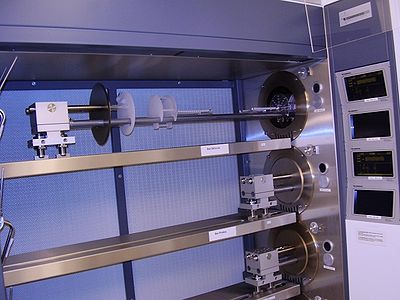Specific Process Knowledge/Thermal Process/A1 Bor Drive-in furnace
Feedback to this page: click here
This page is written by DTU Nanolab internal
Boron Drive-in and Pre-dep furnace (A1)
The Boron Drive-in and Pre-dep furnace (A1) is a Tempress horizontal furnace for thermal oxidation of silicon wafers. Also boron pre-deposition/doping is done in this furnace. Furthermore, the furnace is used for boron drive-in after the pre-deposition or after boron ion implantation.
The furnace is mostly used for wet and dry thermal oxidation of silicon wafers. The oxidation recipes are named e.g. "WET1000" and "DRY1000", where "WET" or "DRY" indicates whether it is a wet or dry oxidation process, and the number indicates the oxidation temperature.
The purpose of the boron doping is to make conductive structures, etch stop layers etc. For pre-deposition of silicon wafers, boron-nitride source wafers are used as doping source. There are only a few source wafers available, i.e. it is not possible to dope an entire batch of 30 wafers, but both sides of the source wafers are available for doping. It is necessary to activate the source wafers before use by heating them for 1 hour at the temperature needed during the pre-deposition (but never at a temperatures lower than 1050 C). During the pre-deposition a boron phase layer is created on the silicon wafers. This layer can be removed in BHF, if argon is used instead of nitrogen for the pre-deposition (at temperatures higher then 1050 C), otherwise the wafers have to be oxidized before the BHF etch. When the boron phase layer has been removed, the wafers can go directly into the furnace again for a drive-in process with or without an oxide growth.
The Boron Drive-in and Pre-dep furnace is the top furnace tube in the furnace A-stack positioned in cleanroom B-1. The furnaces in the A-stack are the cleanest of all furnaces in the cleanroom. Please be aware of that all wafers have to be RCA cleaned before they enter the furnace, and please check the cross contamination information in LabManager, before you use the furnace. Before boron pre-deposition, also the source wafers and a dedicated carbide boat have to be RCA cleaned.
The user manual, quality control instruction and results, technical information and contact information can be found in LabManager:
Boron Drive-in and Pre-dep furnace (A1)
Process knowledge
- Oxidation: look at the Oxidation page
- Boron drive-in: look at the Dope with Boron page
- Boron doping: look at the Dope with Boron page.
Quality Control - Parameters and Limits
| Quality control (QC) for the processes "Wet1050" and "Dry1050" | ||||||||||||||||||||||||||
Numbers from March 2020 |
| Purpose |
|
Thermal oxidation:
Boron pre-deposition/doping:
Driving-in pre-deposited or ion-implanted boron
|
|---|---|---|
| Performance | Film thickness |
|
| Process parameter range | Process Temperature |
|
| Process pressure |
| |
| Gasses on the system |
| |
| Substrates | Batch size |
|
| Substrate materials allowed |
|
